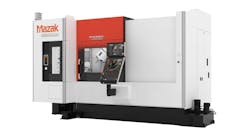If your metal cutting experience is rooted in milling and turning you probably are up-to-date on the latest developments in programming and control. The advances in those process technologies are impressive. But there is a different dimension of controlled precision in manufacturing technology and it’s fairly standard in waterjet technology. With such precision, it’s almost rocket science.
Coincidentally, rocket science is a commercial enterprise too: ending satellites into orbit is a large global industry. In Sweden, a supplier of payload adapters and separation systems for commercial launch vehicles manufacture systems compatible with all commercial satellite buses — and being in that position means constantly investigating ways to develop the rocket science even further. This time it led to new ways to process thick carbon-fiber materials.
The purpose of the payload adapter and separation system is to bring a satellite into orbit. The systems ensure that the satellite and rocket remain securely attached to each other during the ascent into space, and then deliver the valuable payloads into orbit with precision and reliability.
Today, payload adapters are fabricated in aluminum and carbon-fiber material. The two parts are thoroughly bolted together into one big cone, several meters in diameter. The design is impressive, as more than 600 separations have been carried out in orbit with a 100% success rate.
But calculations have shown that payload adapter systems fabricated entirely from carbon-fiber would improve the system’s weight and stiffness significantly. It’s a new design that could increase both rocket efficiency and investment payback. Rather than bolting together the two payload adapter pieces, the same design used for glued laminate ("glulam") construction beams could be used — i.e., finger joints — a design that makes possible a large contact surface, a strong joint and is suitable when joining similar materials.
Because neither milling nor sawing was applicable for processing this kind of design, Water Jet Sweden was contacted to conduct live waterjet test cutting. Complex carbon-fiber geometries are generally difficult to process efficiently without using waterjet cutting, Tony Ryd, chief technology officer at Water Jet Sweden, explained.
The test was performed by cutting 47-mm long finger joints in a cone-shaped, 12-mm-thick carbon-fiber material with a circumference of 7.2 meters. The incision needed a tolerance of 0.1 mm around the circle, in order to be glued together safely and reliably. A Water Jet Sweden advanced FiveX machine system was selected for the test.
“Our FiveX machine system is unique because it has a combination of extreme precision and a full, 3D-abrasive cutting ability. It is specially designed for this kind of advanced applications, cutting with a repetition accuracy of +/- 0.025 mm,” said Tony Ryd.
The test was successful and gave two clear conclusions. First, it proved that full carbon-fiber payload adapters can be produced for future launch vehicles, and second, it showed that abrasive waterjet cutting is a suitable cutting technology for carbon materials and future development of rocket science.








